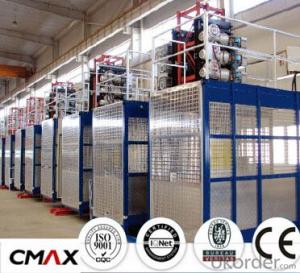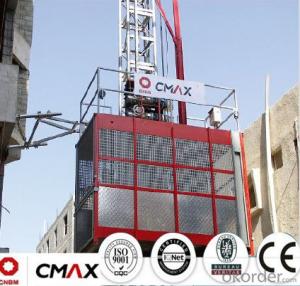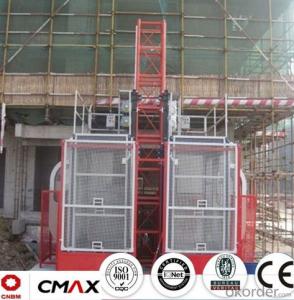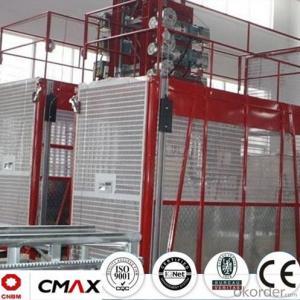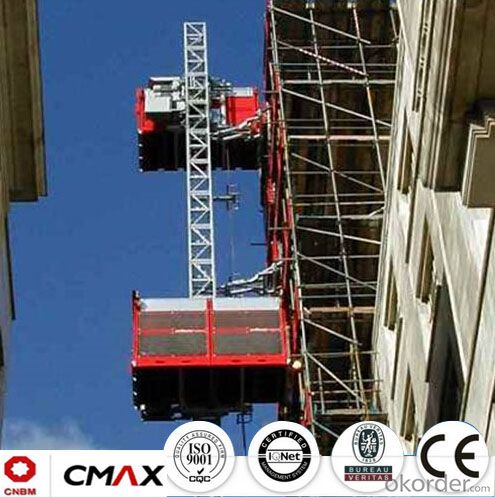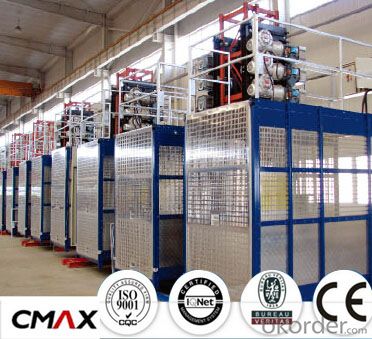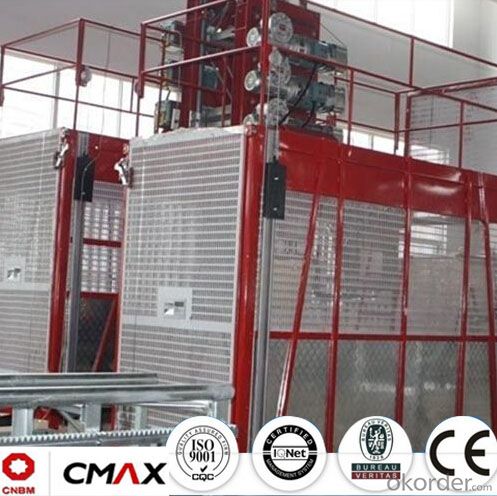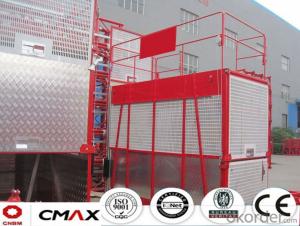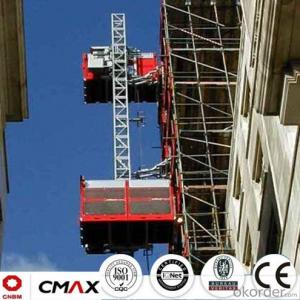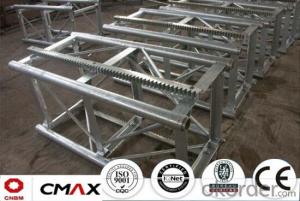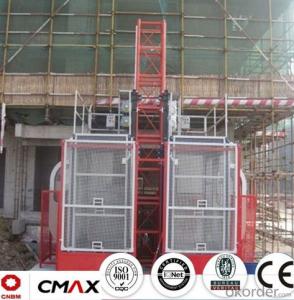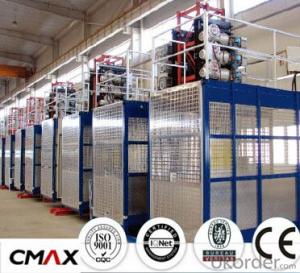Building Hoist Hot Galvanizing Mast Section with Max 5.4ton Capacity
- Loading Port:
- China main port
- Payment Terms:
- TT OR LC
- Min Order Qty:
- 1 unit
- Supply Capability:
- 10 unit/month
OKorder Service Pledge
OKorder Financial Service
You Might Also Like
Structure of Building Hoist with Max 5.4tons Capacity Description
The hoist can be widely used in industrial and civilian construction, bridge, under well, big chimney as well as shipping industry to carry people and materials. As permanent or semi-permanent equipment, hoist can be used in different sites such as warehouse, high tower, etc.
With the advantages of reliable performance, safety, easy carrying, high adaptability, it can reduce operators’ work intensity.
With many advanced technology integrity, strict control on each making process, high ratio of price and quality, CMAX hoist has become a symbol of lifter with high quality and excellent after-sales service.
Packaging & Delivery of Building Hoist with Max 5.4tons Capacity
Packaging: nude and wooded box Delivery: 25-30days
Mains Parts of Building Hoist with Max 5.4tons Capacity
1.Metal structure including the mast, tie in and cabin ,could be spay-painted and hot galvanized. Mast section is produced with high quality Q345B seamless steel pipe.
2.The electrical system can be adopted with the normal control method and VVVF+PLC control method. Inverter we adopted is from Schneider. Yaskawa and other world famous brand.
3.Electric parts are all equipped with Schneider , Siemens and other top brands.
4.Cabin exit door adopts ramping type. The ramping door likes a bridge between the building hoist and construction building.
Building Hoist with Max 5.4tons Capacity Images



Building Hoist with Max 5.4tons Capacity Specification

FAQ of Building Hosit with Max 5.4ons Capacity Capacity
Q: What is the main structure of building hoist?
A: The P/M construction hoist mainly contains metal structure, driving system, electrical control system, cable guide & protection system, electrical top crane and safety device.
Q: What is the building hoist main purpose?
A: Building hoist equipped with double or single cabin to transport the materials and labors up and down. It's the ideal construction equipment for vertical transportation in the field of construction.
- Q: The construction elevator can not operate during the use of several stages of wind power
- Well, there are no definite rules. It's up to you to decide whether to use it or not
- Q: Explain the differences between electric and electric-motor-driven building hoists in a few sentences.
- <p>Electric hoists are powered directly by electricity and use electric motors to lift and lower loads. They are typically smaller and more portable, suitable for lighter loads and indoor use. Electric-motor-driven hoists, on the other hand, use an electric motor to power a separate mechanism, often a winch or pulley system, to move loads. These are generally more robust, capable of handling heavier loads, and are often used in construction and industrial settings. The main differences lie in their power transmission methods, load capacity, and the environments in which they are used.</p>
- Q: Is it permissible to use a building hoist for the purpose of lifting hazardous materials?
- <p>A building hoist is typically not designed for lifting dangerous materials. It is meant for the transportation of construction materials and personnel within a building. Lifting hazardous materials requires specialized equipment and procedures to ensure safety. Always refer to the manufacturer's guidelines and local regulations for the appropriate use of hoisting equipment and handling of dangerous materials.</p>
- Q: This question asks about the various types of control systems used in building hoists, which are essential for the safe and efficient operation of construction elevators.
- <p>There are several types of building hoist control systems that ensure the safe and efficient operation of construction elevators. These include: 1. Manual Control Systems: Operated by a human operator who controls the hoist's movement. 2. Semi-Automatic Control Systems: Combine manual operation with some automated features, like automatic level selection. 3. Fully Automatic Control Systems: Completely automated, with the hoist moving between floors without manual intervention. 4. Microprocessor-Based Control Systems: Utilize advanced microprocessors for precise control and monitoring. 5. PLC-Based Control Systems: Use Programmable Logic Controllers for robust and customizable control. 6. Wireless Control Systems: Enable remote operation and monitoring of the hoist. Each system has its advantages and is chosen based on specific project requirements, safety standards, and budget considerations.</p>
- Q: Can a building hoist be utilized for lifting objects that exceed manual lifting capabilities?
- <p>Yes, building hoists are specifically designed to lift and transport objects that are too large or heavy for manual lifting. They are commonly used in construction to move materials and equipment to various levels of a building. Building hoists are equipped with safety features and can handle substantial weight, making them an essential tool in construction projects where heavy objects need to be moved efficiently and safely.</p>
- Q: This question asks for methods to prevent leakage in hydraulic cylinders used in building hoists.
- <p>To prevent hydraulic cylinder leaks in a building hoist, follow these steps: Regularly inspect and maintain the hydraulic system to ensure all seals and gaskets are in good condition. Replace any worn or damaged components promptly. Ensure the hydraulic oil is clean and at the correct level to avoid air bubbles or cavitation which can cause leaks. Check the cylinder rods for scratches or damage and polish or replace them if necessary. Maintain the correct operating pressure and avoid overloading the hoist. Regularly lubricate moving parts to reduce friction and wear. Implement a routine maintenance schedule to catch and address potential issues before they lead to leaks.</p>
- Q: This question asks whether a double-rope lifting system can be safely and effectively used in both indoor and outdoor environments, specifically during windy conditions.
- <p>A double-rope lifting system can be used both indoors and outdoors, but its use in windy conditions requires careful consideration. Indoors, it is generally safe and effective. Outdoors, windy conditions can pose challenges. High winds may cause the load to sway, potentially leading to accidents. Therefore, it's crucial to adhere to safety guidelines, which often recommend not using such systems in winds exceeding certain speeds, typically around 20-30 mph. Always check the manufacturer's specifications and local regulations for safe operating conditions.</p>
- Q: Is it possible to use a building hoist for lifting heavy materials that cannot be manually lifted?
- <p>Yes, a building hoist is specifically designed for lifting heavy materials that are too heavy or cumbersome to lift manually. These hoists are engineered to handle significant weight loads and are commonly used in construction settings to move materials such as bricks, cement, and steel beams to various levels of a building. They are an essential tool for safe and efficient material handling in construction projects.</p>
- Q: This question asks about the safety measures that should be taken to ensure the safe operation of a building hoist during lifting.
- <p>To ensure the safety of the lifting operation of a building hoist, several key measures should be taken: Regular inspection and maintenance of the hoist equipment to ensure all components are in good working order. Adherence to the manufacturer's guidelines and safety standards for operation. Proper training for operators to ensure they understand how to use the hoist safely. Implementing a safety checklist before each use. Ensuring the load is secured properly and does not exceed the hoist's weight capacity. Using appropriate safety gear such as safety harnesses and helmets. Having a spotter or signal person to assist the operator and watch for potential hazards. Regularly checking the weather conditions to avoid operating in high winds or other adverse weather that could compromise safety.</p>
- Q: Whether the construction elevator is a dual-purpose elevator
- The vertical transportation machinery in construction is mainly the material elevator and construction elevator. Material hoist can slide can't manned, suitable for multilayer use, construction elevator is used only for the top, both manned and can slide, in general the construction elevator for dual-use goods of choose and employ persons outside the elevator.
Send your message to us
Building Hoist Hot Galvanizing Mast Section with Max 5.4ton Capacity
- Loading Port:
- China main port
- Payment Terms:
- TT OR LC
- Min Order Qty:
- 1 unit
- Supply Capability:
- 10 unit/month
OKorder Service Pledge
OKorder Financial Service
Similar products
Hot products
Hot Searches
Related keywords

